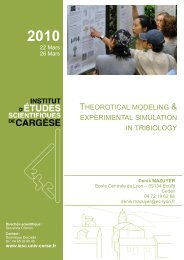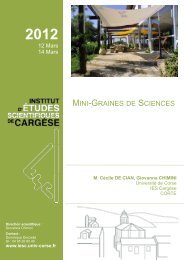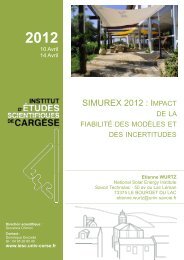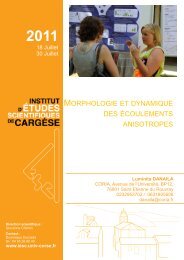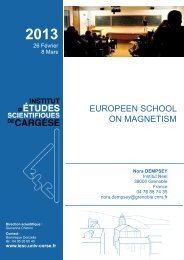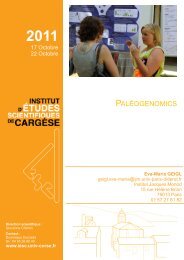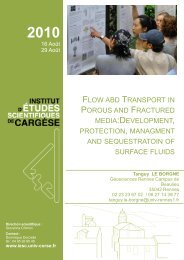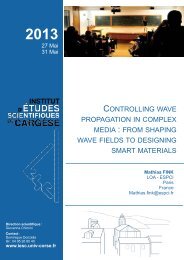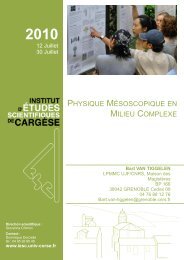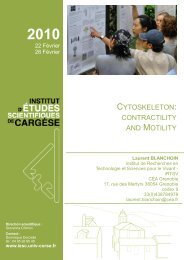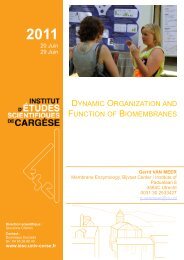nanoelectronics - Institut d'Études Scientifiques de Cargèse (IESC)
nanoelectronics - Institut d'Études Scientifiques de Cargèse (IESC)
nanoelectronics - Institut d'Études Scientifiques de Cargèse (IESC)
Create successful ePaper yourself
Turn your PDF publications into a flip-book with our unique Google optimized e-Paper software.
Posters<br />
Non-adiabatically driven electron in quantum wire<br />
T. Ca<strong>de</strong>z 1 , J. H. Jefferson 2 and A. Ramsak 1,3<br />
1<br />
J. Stefan <strong>Institut</strong>e, Ljubljana, Slovenia<br />
2<br />
Department of Physics, Lancaster University, Lancaster LA1 4YB, UK<br />
3<br />
Faculty of Mathematics and Physics, University of Ljubljana, Ljubljana, Slovenia<br />
An exact solution is <strong>de</strong>rived for the wave function of an electron in a semiconductor quantum<br />
wire with spin-orbit interaction and driven by external time <strong>de</strong>pen<strong>de</strong>nt harmonic confining<br />
potential [1]. The formalism allows analytical expressions for various quantities to be <strong>de</strong>rived,<br />
such as spin and pseudo-spin rotations, energy and occupation probabilities for excited<br />
states. It is <strong>de</strong>monstrated how perfect spin and pseudo-spin flips can be achieved at high<br />
frequencies of or<strong>de</strong>r , the confining potential level spacing. By an appropriately chosen<br />
driving term, spin manipulation can be exactly performed far into the non-adiabatic regime.<br />
Implications for spin-polarised emission and spin-<strong>de</strong>pen<strong>de</strong>nt transport are also discussed.<br />
[1] T. Ca<strong>de</strong>z, J. H. Jefferson and A. Ramsak, Non-adiabatically driven electron in quantum<br />
wire, arXiv: 1208.5359<br />
__________________________________________________________________________<br />
Spin-orbit effects in nanowire-based wurtzite semiconductor quantum dots<br />
Guido Intronati (1,2,3) , Pablo Tamborenea (1) , Rodolfo Jalabert (2) , Dietmar Weinmann (2)<br />
(1) Departamento <strong>de</strong> Física, Universidad <strong>de</strong> Buenos Aires, Ciudad Universitaria, Pab. I,<br />
C1428EHA Buenos Aires, Argentina<br />
(2) <strong>Institut</strong> <strong>de</strong> Physique et Chimie <strong>de</strong>s Matériaux <strong>de</strong> Strasbourg, UMR 7504, CNRS-UdS, 23<br />
rue du Loess, BP 43, 67034 Strasbourg Ce<strong>de</strong>x 2, France<br />
(3) Service <strong>de</strong> Physique <strong>de</strong> l'Etat Con<strong>de</strong>nsé CNRS URA 2464, CEA Saclay, 91191 Gif-sur-<br />
Yvette, France<br />
We study the effects of spin-orbit interaction on the electronic states and spin relaxation<br />
rates of cylindrical quantum dots <strong>de</strong>fined on wurtzite quantum wires. The linear and cubic<br />
contributions of the bulk Dresselhaus spin-orbit coupling are taken into account, along with<br />
the influence of an external magnetic field. An analytic solution for the electronic states that<br />
was previously found for cylindrical pillbox zincblen<strong>de</strong> quantum dots with Rashba interaction<br />
is exten<strong>de</strong>d here to the case of wurtzite dots. The energy spectrum is computed, and the<br />
electronic states for InAs are characterized. This may be a useful aspect of this compound<br />
from the point of view of applications to spin manipulation.



